Authors: Vandvik V1, Eycott AE2,3
Reviewers: Tielbörger K4, Wilfahrt P5
Measurement unit: number of seeds m-2 or m-3; Measurement scale: plot; Equipment costs: €; Running costs: €; Installation effort: medium; Maintenance effort: high; Knowledge need: high (seedling identification skills); Measurement mode: manual
When mature and viable seeds reach the soil surface, germination may either take place immediately or be delayed for a shorter or longer period of time. If germination is delayed for an extended time, the seeds on or in the soils are said to form the soil seed bank (e.g. Fenner and Thompson 2005; Baskin & Baskin, 2014). Seeds can enter and persist in the soil seed bank for a variety of reasons, chiefly because i) the environmental conditions are not suitable for germination (such as in winter or under a drought or dry season when the temperature or water required for metabolic activity are not available to the seed), ii) the germination requirements of the species are not met (specific light or temperature regimes, etc.), or iii) the seeds are dormant (i.e. they have evolved intrinsic physical or physiological mechanisms for delaying germination until the dormancy is broken or lost, which can happen either in response to specific environmental cues or as a random process). Depending on characteristics of both the species and the environment, seeds can thus remain in the soil seed bank for a range of timespans, from very short-lived seeds surviving only a few days via seeds surviving a few months allowing them to germinate in a particular season, to seeds surviving in the seed bank for years to decades and even centuries. The world record to date of documented seed survival in the soil was set when a team of Russian researchers were able to successfully germinate embryos of Silene stenophylla excavated from the Siberian permafrost, placed inside a modern seed coat and endosperm. The subsequent plants survived to fertile adulthood − the seeds were 30,000 years old (Yashina et al., 2012).
Soil seed banks thus offer plants the opportunity to disperse through time. This has fundamental implications for population and community dynamics, as has been recognised by ecological and evolutionary theory, and documented in numerous empirical studies. On ecological timescales, seed banks represent local “biodiversity reservoirs” that can contribute to local population persistence and biodiversity maintenance through temporal storage effects (Chesson & Huntly, 1997; Faist et al., 2013; Plue & Cousins, 2013), remnant populations (Eriksson, 1996; Plue et al., 2008; Auffret & Cousins, 2011), and the maintenance of a functionally diverse belowground species pool available for germination in response to environmental variability or change (Kalamees & Zobel, 2002; Dostal, 2005; Clark et al., 2007; Enright et al., 2007; Måren & Vandvik, 2009; Anderson et al., 2012; del Cacho & Lloret, 2012). On evolutionary timescales, seed banks increase the mean generation times of populations, thereby affecting the potential rate and even direction of evolutionary change (Brown & Venable, 1986; Evans & Cabin, 1995; Evans & Dennehy, 2005). Seed banks allow evolution of risk-spreading mechanisms such as bet-hedging germination strategies (Cohen, 1968; Evans & Dennehy, 2005; Ayre et al., 2009; Gremer & Venable, 2014) and contribute to the maintenance of genetic and trait diversity within local populations (Cabin et al., 2000; Ayre et al., 2009; Lundemo et al., 2009; Mandak et al., 2012), thus providing a potential source of resilience in the face of disturbance or environmental change. As pointed out by Alexander et al. (2012), disentangling the role of seed banks in community and population dynamics is essential for our general understanding of basic ecological patterns and processes in plant communities. For example, understanding the relative importance of “dispersal through time” via seed banks v. long-distance dispersal through space is essential for understanding metapopulation dynamics and metacommunity assembly (Vandvik & Goldberg, 2006). In this way seed banks can be considered biodiversity reservoirs, containing components of the plant community which are not necessarily present aboveground (Vandvik et al., 2016).
Persistent seed banks are particularly important in environments that are characterised by unpredictable environmental fluctuations, such as, for example, subtropical deserts. In such environments, seed dormancy can provide a hedge against extinction during unfavourable years and helps to exploit, on average, more favourable conditions (Cohen, 1968). As climate plays such an important role in seed production (see protocol 4.1 Sexual plant reproduction), dormancy-breaking, and germination (see protocol 4.2 Seed viability, germinability and dormancy), seed banks can be expected to respond to climate change. The methods discussed here are also relevant to other kinds of global-change experiments or observations (e.g. nitrogen desposition; Plassman et al., 2008), including interactions between climate and other drivers such as nitrogen deposition (e.g. Ochoa-Hueso & Manrique, 2010).
A number of classification schemes has been developed for seed banks (Csontos & Tamas, 2003) and Thompson et al. (1997) pragmatically recognise three main types: transient species where seeds typically remain in the soil less than a year before germinating or dying, short-term persistent species that remain in the soil for 1−5 years, and long-term persistent species that remain in the soil more than 5 years. While these types do not closely match the different ecological and evolutionary roles of seed banks described above, there is some relationship (e.g. species with evolutionary adaptations involving soil seed banks tend to be long-term persistent). It is worth noting that transient species are generally not considered to be part of the soil seed bank sensu stricto and are hence often avoided in sampling soil seed banks (see paragraph on timing of sampling). In addition to seed banks in the soil, some authors consider ripe seeds still on the parent plant but no longer dependent on the parent (serotinous seeds) to also be part of the seed “pool” (Lamont & Enright, 2000). In this protocol we only describe methods for sampling soil seed banks.
4.6.1 What and how to measure?
There are four principal ways of measuring the density and longevity of soil seed banks, each with its inherent strengths and weaknesses. Each of them involves some disturbance of the soil in treatment plots and so experimental designs must allow adequate space regardless of which method is eventually used. In the greenhouse germination method, used in the great majority of soil seed-bank studies, seed banks are sampled by taking soil cores of varying depths, treating as necessary to break dormancy, and then spreading these soils in trays in a greenhouse under conditions suitable for germination. The emerging seedlings are then counted and identified.
In the major alternative approach, the seed extraction method, the seeds are extracted from the soil and then identified to species and counted under a stereomicroscope. In comparative studies, the seed extraction method often reveals more species than the greenhouse germination method (e.g. Brown, 1992), which may be due to the failure to provide suitable conditions for germination and/or break dormancy in germination studies, but also because the seed extraction method may overestimate the seed bank by including dead seeds in the total count (Fenner & Thompson, 2005). While the viability problem can be circumvented, for example using a tetrazolium viability test (see protocol 4.2 Seed viability, germinability and dormancy), the seed extraction method is relatively labour intensive, especially in systems with many small-seeded species, and the method is not widely applied.
Another method is to monitor seedling emergence in situ (e.g. Kadmon & Shmida, 1990; Castillo & Stevenson, 2010; Siewert & Tielbörger, 2010; Plue et al., 2017), which may be better than the greenhouse method at promoting the germination of specialist species with particular environmental requirements and thus gives a more realistic picture of the recruitment potential from the soil seed bank (e.g. Plue et al., 2017). The method also allows for larger individual samples. Also, because of the high level of realism, the in situ method arguably investigates another life-history transition, seedling recruitment, rather than quantifying the size and species composition of the soil seed bank per se. These methods require the exclusion of the natural seed rain, however, which may be difficult in climate-manipulation studies and may also affect the microenvironment (e.g. netting might incur shading and increased moisture), which again might affect germination and survival probabilities. See Kadmon & Shmida, 1990 and Siewert & Tiellbörger, 2010 for how this can be achieved in desert annual communities.
A final method is to bury bags of seeds in the soil, and then exhume these after a given time (211 such studies with a duration ranging from 1−120 years are reported in Fenner & Thompson, 2005; see Telewski & Zeevaart, 2002 for the 120- year experiment). While this yields very direct estimates of seed longevity in soil, which may be very useful in demographic studies and other species-level approaches, it is less suited for assessment of the entire seed-bank community as such, and will therefore not be considered further here (see below for alternative approaches to assessing seed longevity).
Recognising the different strengths and weaknesses of these different methods, we follow the major practice in the literature (see e.g., Fenner & Thompson, 2005) and recommend germination from soil cores as the gold standard protocol for assessing seed-bank density and species composition. We also suggest a number of measures such as bulk reduction and careful selection of germination (pre‑)treatments to reduce dormancy and other issues with this method (ter Heerdt et al., 1996; Måren & Vandvik, 2009). The aim of these suggestions is to maximise the representation of the true viable persistent seed bank by the sampling.
Timing of sampling: this depends on the research question, but if you are interested in the persistent seed pool (sensu Thompson & Grime, 1979), then sampling should be done after the main seasonal germination peak and before the main seed dispersal period. For example, in temperate and boreal systems, this generally means that sampling should be done in the early to mid summer, before peak biomass (and, crucially, after spring germination peak and before the following autumnal seed dispersal peak). If the focus is instead on the range of seeds available at the start of the growing season, select the time between the peak of unseasonable conditions (usually dry season at low latitudes and winter at high latitudes) and the onset of growing season germination. In that way, species needing a seasonal dormant period, such as vernalisation, have received those conditions, reducing the need for dormancy-breaking treatments during sample processing (Thompson et al., 1997). If this is not practical, it may be necessary to subject the samples to artificially-induced conditions reflecting the dormant period (also known as stratification). Samples from damp environments should not be completely dry during stratification (Baskin & Baskin, 2014).
Field sampling of seed banks from the soil − spatial sampling strategy: soil seed banks are notoriously patchy (Thompson et al., 1997) and sampling methods should be carefully chosen and the resulting data interpreted with this in mind. For studies aiming to achieve a representative sample of the seed-bank community, the classical recommendation has been to take many small samples rather than a few larger ones (Molau & Mølgaard, 1996; Thompson et al., 1997). The number of samples (and total volume) needed varies with the research question and the study system, where fewer and smaller samples are needed in systems with higher seed densities (see discussion in Thompson et al., 1997).
Samples intended for direct comparisons with aboveground vegetation data should be taken at a grain size and sampling effort comparable to that vegetation, yet published studies typically report seed bank sampling area of 1−5% of the corresponding vegetation sampling area (this concerns both individual samples and total datasets; Thompson et al., 1997; Vandvik et al., 2016). The species–area relationships of the soil v. vegetation are surprisingly similar across scales, regions, and habitats (see field data and literature review reported in Vandvik et al., 2016), suggesting that direct comparisons of the biodiversity of vegetation and seed banks with unmatched sampling grain sizes are not valid, at least not for highly spatially structured data such as species richness. Comparable data for species richness can be achieved by increasing sampling effort and grain size for the seed bank to be comparable to the aboveground vegetation, but also by sampling the vegetation at a finer gain (i.e. nested or sub-plot designs, see protocol 4.8 Plant community composition). These results also imply that studies aiming to detect with some degree of certainty all species present in the seed bank should use similar grain sizes and sampling efforts (per unit area) as the vegetation. This may prove untenable, in many cases.
For less spatially structured responses such as community composition and some similarity and diversity indices (see below), comparing vegetation and seed bank data collected using different sampling effort and grain sizes may still be appropriate. It may be necessary to take several small subsamples and bulk them together at the plot scale (Figure 4.6.1). For studies aiming to compare community composition of the vegetation and seed bank, Plue & Hermy (2012) recommend a minimum sample of 3% of a plots’ surface area with subsamples taken along a systematic grid covering the whole plot. Samples taken from closer than 30 cm are not independent in composition across a range of habitats, and so for sufficiently large plots it will be beneficial to space the subsamples at a greater distance than this (Plue & Hermy, 2012). Whatever the sampling strategy, the sample should be of a fixed area and depth per site or treatment.
Sampling depth: the majority of seeds are found in the upper layers, i.e. the upper 2 cm. If the aim is to recover as much as possible of the seed bank composition and diversity, it may be more cost-effective to sample a larger area than greater depths, unless the seed bank of the deeper layers is of interest (e.g. for time-series or age estimations; see below). However, for a full description of the seed bank, 10 cm is the minimum recommended depth in deep soils: more than 40 cm is most likely excessive (Thompson et al., 1997; Eycott et al., 2006). The depth of a seed indicates how long it has been in the soil (although not exactly) and so many seed bank studies keep soil layers separate in order to make inferences about the age of the seeds of different species (Figure 4.6.1). Divisions could then be: i) 0−1 cm, ii) 1−3 cm, iii) 3−5 cm, and iv) 5−10 cm, as was used in ITEX (Molau & Mølgaard, 1996).
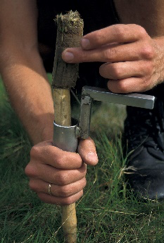 |
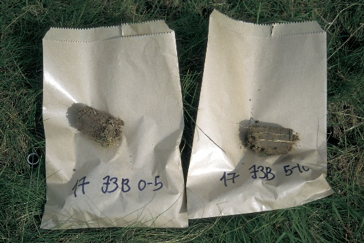 |
 |
|
Figure 4.6.1 Soil seed bank sampling. Cylindrical metal cores of known dimensions are useful for sampling known depths and volumes of soil. a) A stout stick of slightly smaller diameter than the core is being used to gently push the sample out of the core, with a handle fitted to the core to ease extraction from the ground. Both these and a rubber mallet can be useful for sampling hard or dense soils. b) Cores can be divided into different layers and c) replicate cores can be sampled from across vegetation plots and either be combined to a composite sample or kept separate for more detailed spatial analyses. Photos: Vigdis Vandvik. |
||
Lab preparation of seed bank samples: the soil should be passed through a large-grain sieve to remove stones, roots, and large leaves and to homogenise the sample (e.g. 2 mm sieve; Molau & Mølgaard, 1996). Use a bigger grid size than the largest reasonably expected seed. Take care to not damage the seeds but ensure that all the soil sticking to the roots or stones gets broken up. If suitable (e.g. for loamy soils) the sample can then be washed through a small-grid sieve using liberal amounts of water (a hand-held shower can be useful) to reduce the bulk sample and concentrate the seeds in the sieve (ter Heerdt et al., 1996). Note that, for example, Juncus seeds can be 0.3 mm and orchid seeds even smaller, so this sieve should be smaller than the smallest seed reasonably expected. In testing this approach, ter Heerdt (1996) found that it greatly reduces soil bulk and thereby decreases greenhouse space need and/or increases the original sample volume that can be processed. The volume-reduced samples germinated to higher percentages than unconcentrated samples, and 81−100% of the seeds remained viable, suggesting the method causes relatively little harm to seeds. The samples should then be laid out in a thin layer (< 0.5 cm, because even this little soil cover creates uneven environmental conditions and can inhibit germination in light-demanding species) over a thick layer of sterile substrate, for example 5 cm of a 1:1:1 mix of sterile peat, potting soil, and perlite, as this allows moisture conditions to be kept as constant as possible, thereby ensuring seedlings are kept alive until they can be identified (Måren & Vandvik, 2009). Note that germination requirements, and therefore optimal conditions for seedling emergence, may differ between study systems and this should be reflected in the greenhouse protocols (e.g. full light or shade; seeds on top of soil or covered by a thin layer of substrate; high, low, constant, or variable temperatures or light; high or low moisture). In any case, the conditions should be optimised so as to maximise germination in the system at hand (see 4.6.2. Special cases below).
Greenhouse methods: trays should be placed in random order in a greenhouse and should be rotated to new positions at regular intervals (Figure 4.6.2). Control trays of the same sterile substrate used for the samples should be randomly interspersed among the samples to control for contamination from in and around the greenhouses, for example airborne seeds arriving via ventilation systems (Eycott et al., 2006). The greenhouse light and heat regime should reflect optimal conditions for the seeds or for the study system, for example samples from the high arctic should have 24-hour light, while for alpine and low arctic sites 16−18 h has been used (Molau & Mølgaard, 1996). The Handbook of Field Sampling Protocols for Biodiversity Indicator Monitoring (James Hutton Institute, 2011) suggests between 15 and 18 °C for 12 h for samples from temperate regions.
Visit the samples regularly and uproot seedlings as soon as they can be identified (manuals of seedling identification are available for some ecosystems, e.g. Muller, 1978; Garwood & Tebbs, 2009). Species which need to flower in order to be identified should be moved into new pots so as to not inhibit further germination (Figure 4.6.2). The amount of time for which the samples should be kept depends on the germination ecology of the component species and how important it is to capture infrequent species. Ter Heedt et al. (1996) found that with their sieving method, 95% of seeds from temperate marshland had germinated within six weeks, whereas a study in temperate mixed old-growth forest observed new species emerging after three years (Jaroszewicz, pers. comm.). In a greenhouse without artificial lighting, a year will permit all species with day length-related germination requirements to have the opportunity to germinate. In reality, whilst longer is probably better, many studies will be constrained instead by logistical limitations.
Data reporting and calculations: the data should be reported in seeds per species per m2 or m3, and information about both the total m2 and total m3 sampled (i.e. sampling area and sampling depth) and the grain and extent (subsample spatial sampling design; sample mixing) should be reported. Data on species composition and various similarity and diversity indices can be calculated from these data.
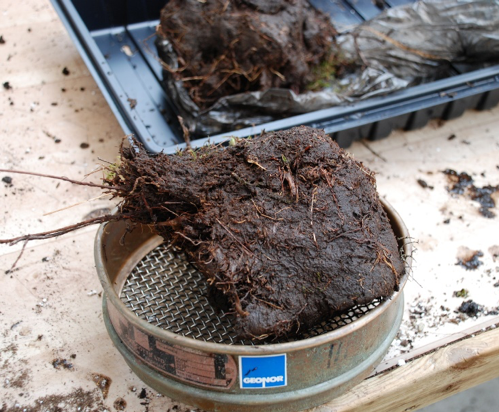 |
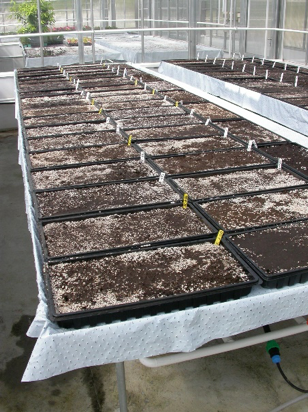 |
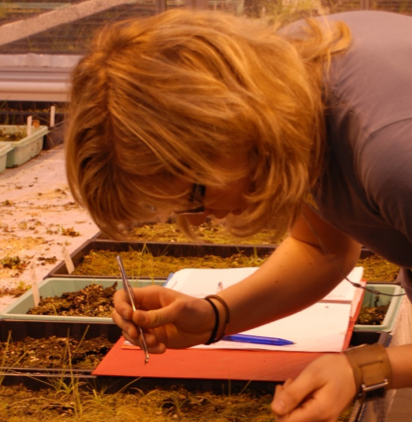 |
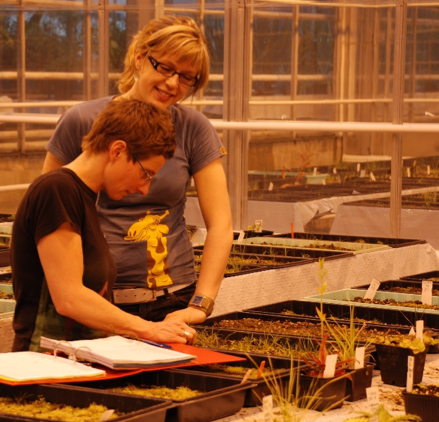 |
| Figure 4.6.2 Soil seed bank sample processing. a) Sieving to remove large stones and roots. b) Laying out samples as evenly as possible. It is usually necessary to move samples around regularly, even in well-lit greenhouses. c) Seedlings are removed and the roots brushed gently so that other seeds are not carried on the roots. d) Individuals which cannot be identified to species from the seedlings must be carefully transferred to new pots to avoid shading out other germinating individuals. Photos: Vigdis Vandvik. | |
Where to start
Ter Heerdt et al., (1996), Måren & Vandvik (2009), Molau & Mølgaard (1996), Plue et al. (2012), Thompson et al. (1997).
4.6.2 Special cases, emerging issues, and challenges
Special cases for particular environments – this is not an exhaustive list
-
-
- Wetland samples may need to be placed in troughs to support inundation-demanding species, but that may also inhibit others (Poiani & Johnson, 1988).
- Soil seed bank samples from in the polar desert need only be very shallow – even only 1 cm (Molau & Mølgaard, 1996).
- Annual plant communities, such as from agricultural fields or deserts, have particular challenges and opportunities and may need to be sampled and analysed in different ways (see Kadmon & Schmida, 1990; Siewert & Tielbörger, 2010).
- Some seeds, particularly tropical forest trees, are recalcitrant – they do not tolerate drying, so the samples should not be allowed to get dry (moisture content of seed below 30%). Tropical tree seeds can also be very large and so may need hand-selecting at the sieving stage.
- There are relatively few tropical seed-bank studies in the same way as there are relatively few tropical climate-manipulation studies. See Garwood (1989) for a review, updated for forests by Esaete et al. (2014, Appendix 1).
- If the mechanisms by which seed dormancy is broken are unknown or difficult to reproduce experimentally, one option is to store the freshly produced seeds under field conditions during the unfavourable season (e.g. winter or dry season). This can promote dormancy breaking by the natural cues.
-
4.6.3 References
Theory, significance, and large datasets
Thompson et al. (1997), Vandvik et al. (2016) for a review of seed bank species-area relationships.
More on methods and existing protocols
Plue & Hermy (2012), Plue et al. (2017) for a review of sample sizes and spacings
All references
Alexander, H. M., Foster, B. L., Ballantyne, F., Collins, C. D., Antonovics, J., & Holt, R. D. (2012). Metapopulations and metacommunities: combining spatial and temporal perspectives in plant ecology. Journal of Ecology, 100(1), 88-103.
Anderson, T. M., Schütz, M., & Risch, A. C. (2012). Seed germination cues and the importance of the soil seed bank across an environmental gradient in the Serengeti. Oikos, 121(2), 306-312.
Auffret, A. G., & Cousins, S. A. O. (2011). Past and present management influences the seed bank and seed rain in a rural landscape mosaic. Journal of Applied Ecology, 48, 1278-1285.
Ayre, D. J., Ottewell, K. M., Krauss, S. L., & Whelan, R. J. (2009). Genetic structure of seedling cohorts following repeated wildfires in the fire-sensitive shrub Persoonia mollis ssp. nectens. Journal of Ecology, 97(4), 752-760. 227
Baskin, C. C., & Baskin, J. M. (2014). Seeds. Ecology, Biogeography and Evolution of Dormancy and Germination (2nd ed.). Academic Press.
Brown, D. (1992). Estimating the composition of a forest seed bank: a comparison of the seed extraction and seedling emergencemethods. Canadian Journal of Botany, 70, 1063-1612.
Brown, J. S., & Venable, D. L. (1986). Evolutionary ecology of seed-bank annuals in temporally varying environments. The American Naturalist, 127, 31-47.
Cabin, R. J., Marshall, D. L., & Mitchell, R. J. (2000). The demographic role of soil seed banks. II. Investigations of the fate of experimental seeds of the desert mustard Lesquerella fendleri. Journal of Ecology, 88(2), 293-302.
Castillo, L. S., & Stevenson, P. R. (2010). Relative importance of seed-bank and post-disturbance seed dispersal on early gap regeneration in a Colombian Amazon forest. Biotropica, 42(4), 488-492.
Chesson, P., & Huntly, N. (1997). The roles of harsh and fluctuating conditions in the dynamics of ecological communities. The American Naturalist, 150, 519-553.
Clark, C. J., Poulsen, J. R., Levey, D. J., & Osenberg, C. W. (2007). Are plant populations seed limited? A critique and meta-analysis of seed addition experiments. The American Naturalist, 170(1), 128-142.
Cohen, D. (1968). A general model of optimal reproduction in a randomly varying environment. Journal of Ecology, 56, 219-228.
Csontos, P., & Tamás, J. (2003). Comparisons of soil seed bank classification systems. Seed Science Research, 13(2), 101-111.
del Cacho, M., & Lloret, F. (2012). Resilience of Mediterranean shrubland to a severe drought episode: the role of seed bank and seedling emergence. Plant Biology, 14, 458-466.
Dostal, P. (2005). Is the population turnover of patchy-distributed annuals determined by dormancy dynamics or dispersal processes? Ecography, 28, 745-756.
Enright, N. J., Mosner, E., Miller, B. P., Johnson, N., & Lamont, B. B. (2007). Soil vs. canopy seed storage and plant species coexistence in species-rich Australian shrublands. Ecology, 88, 2292-2304.
Eriksson, O. (1996). Regional dynamics of plants: a review of evidence for remnant, source–sink and metapopulations. Oikos, 77, 248-258.
Esaete, J., Eycott, A. E., Reiniö, J., Telford, R. J., & Vandvik, V. (2014). The seed and fern spore bank of a recovering African tropical forest. Biotropica, 46(6), 677-686.
Evans, A. S., & Cabin, R. J. (1995). Can dormancy affect the evolution of post-germination traits – the case of Lesquerella fendleri. Ecology, 76, 344-356.
Evans, M. E. K., & Dennehy, J. J. (2005). Germ banking: bet-hedging and variable release from egg and seed dormancy. Quarterly Review of Biology, 80, 431-451.
Eycott, A. E., Watkinson, A. R., & Dolman, P. M. (2006). The soil seedbank of a lowland conifer forest: the impacts of clear-fell management and implications for heathland restoration. Forest Ecology and Management, 237(1-3), 280-289.
Faist, A. M., Ferrenberg, S., & Collinge, S. K. (2013). Banking on the past: seed banks as a reservoir for rare and native species in restored vernal pools. AoB Plants, 5, plt043.
Fenner, M., & Thompson, K. (2005). The Ecology of Seeds. Cambridge: Cambridge University Press.
Garwood, N. C. (1989). Tropical soil seed banks: a review. In M. A. Leck, V. T. Parker, & R. L. Simpson (Eds.), Ecology of Soil Seed Banks (pp. 149-209). San Diego, CA: Academic Press Inc.
Garwood, N. C., & Tebbs, M. C. (2009). Seedlings of Barro Colorado Island and the Neotropics. Comstock Publishing Associates/Cornell University Press.
Gremer, J. R., & Venable, D. L. (2014). Bet hedging in desert winter annual plants: optimal germination strategies in a variable environment. Ecology Letters, 17, 380-387.
James Hutton Institute (2011). Handbook of Field Sampling Protocols for Biodiversity Indicator Monitoring. http://www.hutton.ac.uk/sites/default/files/files/A%20Handbook%20of%20biodiversity%20monitoring%20protocols(1).pdf
Kadmon, R., & Shmida, A. (1990). Spatiotemporal demographic processes in plant populations: an approach and a case study. The American Naturalist, 135(3), 382-397.
Kalamees, R., & Zobel, M. (2002). The role of the seed bank in gap regeneration in a calcareous grassland community. Ecology, 83, 1017-1025.
Lamont, B. B., & Enright, N. J. (2000). Adaptive advantages of aerial seed banks. Plant Species Biology, 15(2), 157-166.
Lundemo, S., Falahati-Anbaran, M., & Stenøien, H. K. (2009). Seed banks cause elevated generation times and effective population sizes of Arabidopsis thaliana in northern Europe. Molecular Ecology, 18, 2798–2811.
Mandak, B., Zákravský, P., Mahelka, V., & Plačková, I. (2012). Can soil seed banks serve as genetic memory? A study of three species with contrasting life history strategies. PLoS ONE, 7, e49471.
Måren, I. E., & Vandvik, V. (2009). Fire and regeneration: the role of seed banks in the dynamics of northern heathlands. Journal of Vegetation Science, 20, 871-888.
Molau, U., & Mølgaard, P. (1996). ITEX Manual – International Tundra Experiment (2nd ed.) Copenhagen: Danish Polar Centre. http://ibis.geog.ubc.ca/itex/PDFs/ITEXmanual.pdf
Muller, F. M. (1978). Seedlings of the North-Western European Lowland. Dordrecht: Springer.
Ochoa-Hueso, R., & Manrique, E. (2010). Nitrogen fertilization and water supply affect germination and plant establishment of the soil seed bank present in a semi-arid Mediterranean scrubland. Plant Ecology, 210(2), 263-273.
Plassmann, K., Brown, N., Jones, M. L. M., & Edwards-Jones, G. (2008). Can atmospheric input of nitrogen affect seed bank dynamics in habitats of conservation interest? The case of dune slacks. Applied Vegetation Science, 11(3), 413-420.
Plue, J., & Cousins, S. A. O. (2013). Temporal dispersal in fragmented landscapes. Biological Conservation, 160, 250-262.
Plue, J., & Hermy, M. (2012). Consistent seed bank spatial structure across semi-natural habitats determines plot sampling. Journal of Vegetation Science, 23, 505-516.
Plue, J., Hermy, M., Verheyen, K., Thuillier, P., Saguez, R., & Decocq, G. (2008). Persistent changes in forest vegetation and seed bank 1600 years after human occupation. Landscape Ecology, 23(6), 673-688.
Plue, J., Thompson, K., Verheyen, K., & Hermy, M. (2012). Seed banking in ancient forest species: why total sampled area really matters. Seed Science Research, 22(2), 123-133.
Plue, J., Colas, F., Auffret, A. G., & Cousins, S. A. O. (2017). Methodological bias in the seed bank flora holds significant implications for understanding seed bank community functions. Plant Biology, 19(2), 201-210.
Poiani, K. A., & Johnson, W. C. (1988). Evaluation of the emergence method in estimating seed bank composition of prairie wetlands. Aquatic Botany, 32(1-2), 91-97.
Siewert, W., & Tielbörger, K. (2010). Dispersal-dormancy relationships in annual plants: putting model predictions to the test. The American Naturalist, 176(4), 490-500.
Telewski, F. W., & Zeevaart, J. A. (2002). The 120‐yr period for Dr. Beal’s seed viability experiment. American Journal of Botany, 89(8), 1285-1288.
Ter Heerdt, G. N. J., Verweij, G. L., Bekker, R. M., & Bakker, J. P. (1996). An improved method for seed-bank analysis: seedling emergence after removing the soil by sieving. Functional Ecology, 10, 144-151.
Thompson, K., & Grime, J. P. (1979). Seasonal variation in the seed banks of herbaceous species in ten contrasting habitats. Journal of Ecology, 67(3), 893-921.
Thompson, K., Bakker, J. P., & Bekker, R. M. (1997). The Soil Seed Banks of North West Europe: Methodology, Density and Longevity (Vol. 1). Cambridge: Cambridge University Press.
Vandvik, V., & Goldberg, D. E. (2006). Sources of diversity in a grassland metacommunity: quantifying the contribution of dispersal to species richness. The American Naturalist, 168, 157-167.
Vandvik, V., Klanderud, K., Meineri, E., Måren, I. E., & Töpper, J. P. (2016). Seed banks are biodiversity reservoirs: species–area relationships above versus below ground. Oikos, 125, 218-228.
Yashina, S., Gubin, S., Maksimovich, S., Yashina, A., Gakhova, E., & Gilichinsky, D. (2012). Regeneration of whole fertile plants from 30,000-y-old fruit tissue buried in Siberian permafrost. Proceedings of the National Academy of Sciences USA, 109(10), 4008-4013.
Authors: Vandvik V1, Eycott AE2,3
Reviewers: Tielbörger K4, Wilfahrt P5
Affiliations
1 Department of Biological Sciences and Bjerknes Centre for Climate Research, University of Bergen, Bergen, Norway
2 Department of Biological Sciences, University of Bergen, Bergen, Norway
3 Faculty of Biosciences and Aquaculture, Nord University, Steinkjer, Norway
4 Institute of Evolution and Ecology, Plant Ecology Group, University of Tübingen, Tübingen, Germany
5 Department of Disturbance Ecology, BayCEER, University of Bayreuth, Bayreuth, Germany